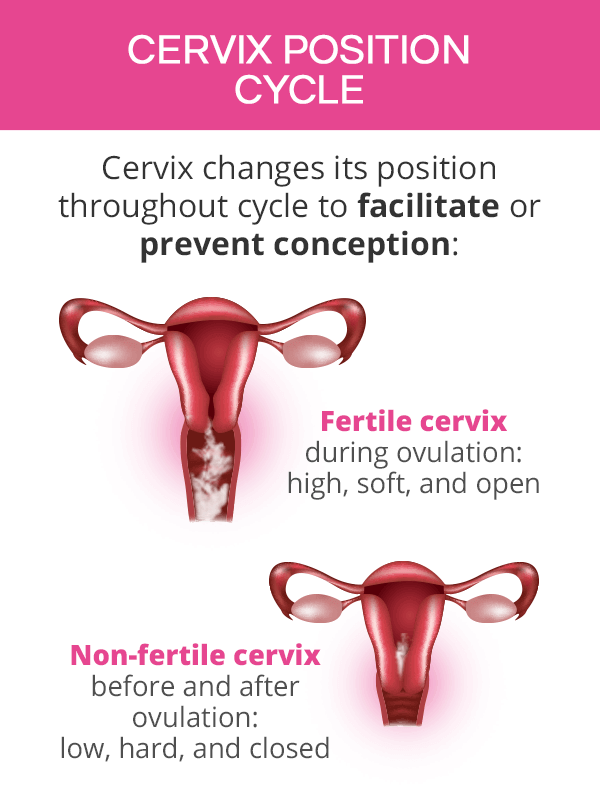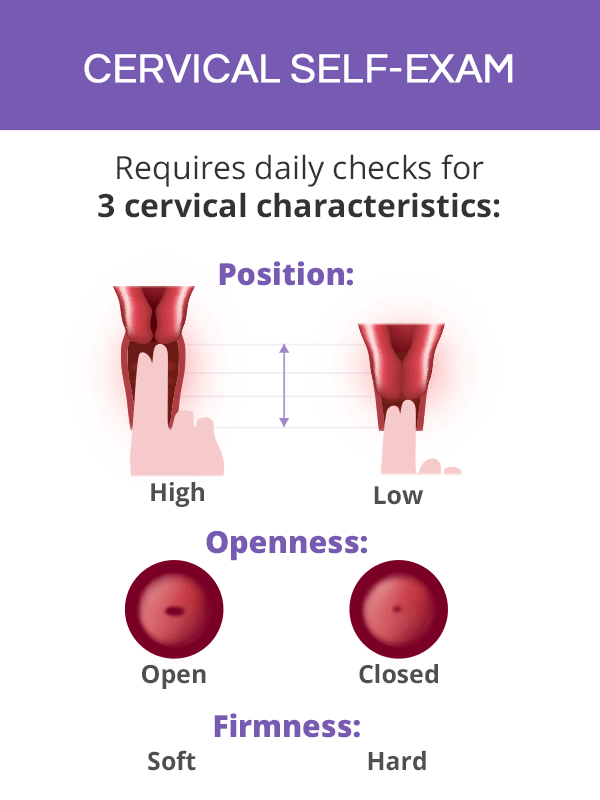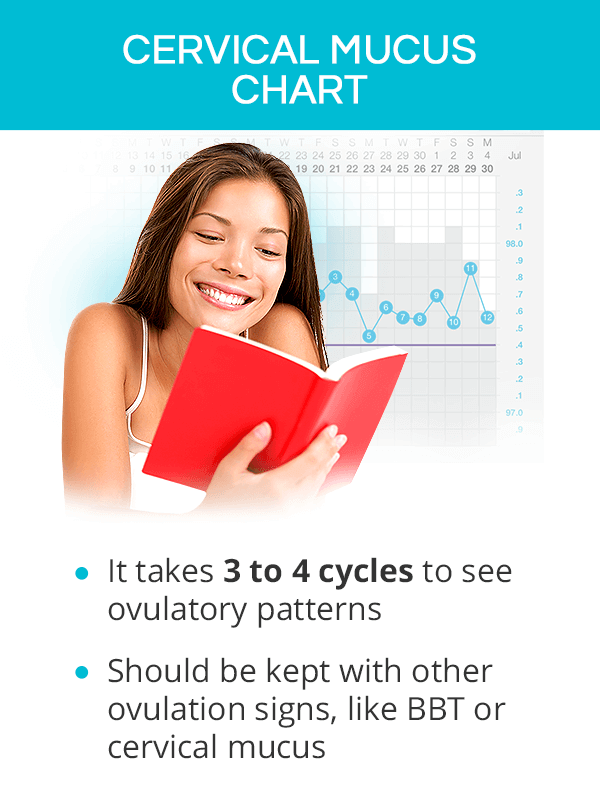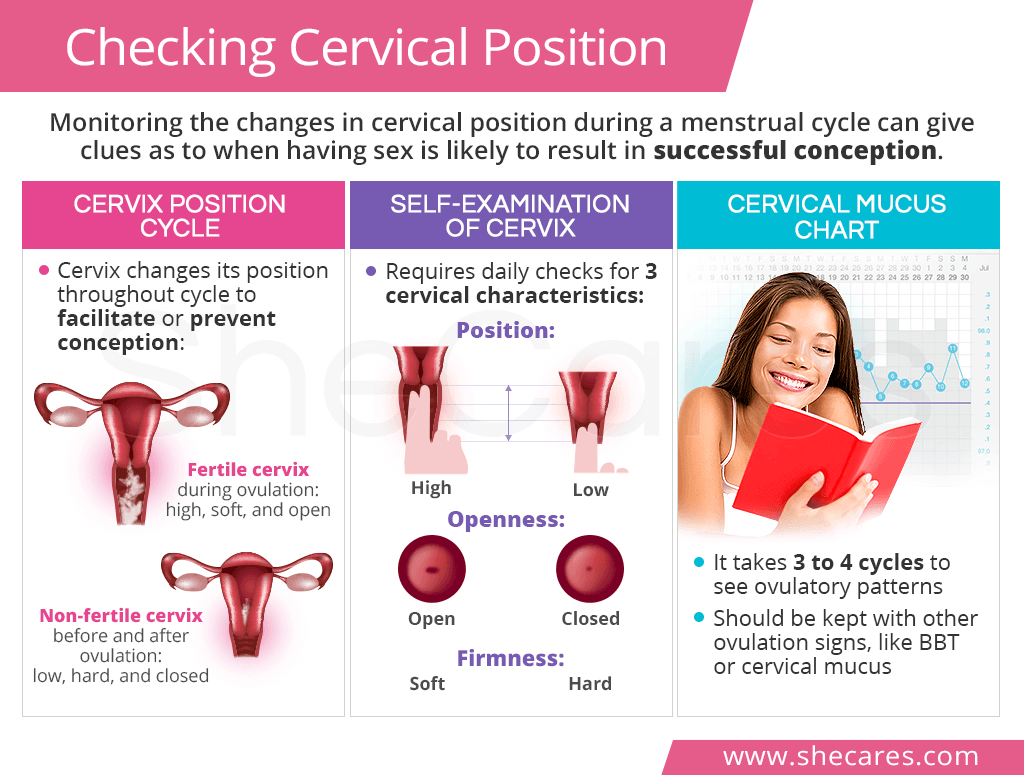Brief Overview of the Cervix
The cervix is a muscular structure within a woman's body that connects the vagina with the uterus.
Serving a doorway to the rest of the reproductive organs, it gives blood passage out from the uterus during menstruation and allows sperm to pass into the uterus during ovulation.
The cervix also secretes cervical mucus, which enables sperm to move up to the fallopian tubes, nourishing it for up to five days to make fertilization more feasible.
The Cervix's Position Throughout the Cycle

Fluctuating levels of estrogen during a menstrual cycle cause detectable changes in the cervix's position and texture, all of which are designed to facilitate or prevent conception.
Cervix before ovulation. During monthly bleeding, the cervix is low, hard, and slightly open. When a period ends, it remains low and hard, but closed, making conception impossible.
Cervix during ovulation. As a woman gets closer to her ovulation, the cervix moves higher into the body and gradually becomes softer, moister, and more open. On ovulation day, the cervix is characteristically high, soft, wet, and open, which indicates it is in the most fertile state.
Cervix after ovulation. Following ovulation, the cervix returns to being low, hard, and closed, indicating that it is not permissible to sperm and a woman is in her infertile days.
If pregnancy has occurred, the cervix will once again move up and become soft, but it will be tightly closed to support the growing fetus. During childbirth, the cervix dilates to up to 4 inches (10cm), which enables the passage of the fetus through the birth canal.1
Checking Cervical Position
Checking cervical position alone is usually not a sufficient way to estimate ovulation. Women are encouraged to look for other ovulation signs and symptoms as well, including fertile cervical mucus, basal body temperature changes, or mild discomforts, such as cramps or bloating.
The main goal of this test is to begin noticing when the cervix becomes high, soft, and open during a menstrual cycle, which signifies approaching ovulation and the best time to have sex.
When to Check Cervical Position
It is best to examine one's cervix roughly at the same time every day for three to four months before trying to conceive.
It is wise to start checking cervical position immediately following a period as it is in its low position and might be easier to be detected manually.
Examining one's cervix right after having sex should be avoided due to the fact that sexual arousal might cause its position to change, potentially producing incorrect observations.
How to Check Cervical Position

To check cervical position, it is best to assume a comfortable position either laying down on the bed, sitting on the toilet, or standing up with one leg elevated for easier access. The same position should be maintained throughout the testing period.
The examination is done by slowly inserting a clean finger into the vagina, gently pushing it up towards the opposite end of the vagina, and examining it with one's finger. The portion of cervix that can be felt manually has a round shape, resembling a small ball, which can be easily differentiated from the surrounding tissues of vaginal wall.
A woman should take note of three characteristics while checking her cervix for ovulation:
- Position: Is it high or low?
- Openness: Is it open or closed?
- Firmness: Is it soft of hard?
Knuckle Rule
Using the Knuckle Rule might be beneficial mid-cycle since the cervix during ovulation is high and might be more difficult to locate.
If the cervix can be detected after inserting a finger until the first knuckle, then the cervix is low. If it takes a whole finger, or three knuckles, to touch the cervix, it means it is high.
Touching the cervix at the level of the second knuckle means that the cervix is in its medium position, which signifies that it is in transition from being low to high, or vice versa.
It is worth keeping in mind that proper hand hygiene and nail trimming prior to self-examination are essential to prevent reproductive tract infections and accidental scratching of delicate vaginal tissues.
Keeping a Cervix Position Chart

Charting cervical position makes estimating ovulation much easier and more accurate as it can produce a reliable pattern of a woman's ovulation cycle, helping her narrow down her most fertile days.
A sample cervix position chart can also include observations taken with other ovulation tests, such as measuring basal body temperature or checking cervical mucus, to ensure better accuracy.
A woman can simply take daily notes in her personal agenda, create a cervix position chart by hand, or use a downloadable fertility chart. To make recording easy, common abbreviations for what should be noted on the chart might include:
- H for high or L for low cervix
- S for soft or HR for hard cervix
- O for open or C for closed cervix
A woman can also take advantage of numerous ovulation predictors, such as ovulation trackers or monitors, which store daily recordings of various ovulation signs to create accurate ovulation predictions.
Conclusions
For most women, it takes several cycles to make sense of the changes occurring in their bodies and correctly associate them with their fertility. Such is the case with checking one's cervical position. Although some may find it uncomfortable at first, tracking cervical changes throughout the cycle is an easy tool that helps estimate the time of ovulation. It can also aid in detection of ovulation problems, which might be the cause of female infertility. With diligence and patience, a woman can take her fertility into her own hands and use bodily cues, such as cervical changes, to increase her chances of becoming a mother.
Sources
- American Pregnancy Association. (2018). Signs and Symptoms of Ovulation. Retrieved September 10, 2018 from http://americanpregnancy.org/getting-pregnant/signs-of-ovulation/
- Better Health. (n.d.). Ovulation. Retrieved September 10, 2018 from https://www.betterhealth.vic.gov.au/health/conditionsandtreatments/ovulation
- David, S. & Blakeway, J. (2009). Making Babies.New York, NY: Little Brown.
- Douglas, A. & Sussman, J. (2004). The Unofficial Guide to Having a Baby. New York, NY: Wiley Publishin.
- Fertility & Sterility. (2013). Cervical mucus monitoring prevalence and associated fecundability in women trying to conceive. Retrieved September 10, 2018 from https://www.ncbi.nlm.nih.gov/pmc/articles/PMC3787999/
- Mayo Clinic. (2016). Ovulation Signs: When is conception most likely? Retrieved September 10, 2018 from https://www.mayoclinic.org/healthy-lifestyle/getting-pregnant/expert-answers/ovulation-signs/faq-20058000
Footnotes:
- American Pregnancy Association. (n.d.). First Stage of Labor. Retrieved September 8, 2021 from https://americanpregnancy.org/healthy-pregnancy/labor-and-birth/first-stage-of-labor/


